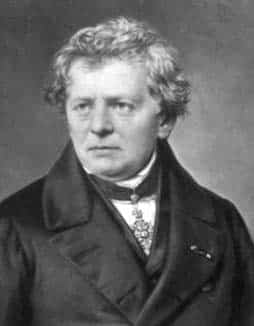At the time Georg Simon Ohm was born not much was known about electricity, he was out to change this. Georg grew up in Bavaria which is why most information about Georg is in German. There is even a College named after him: Georg-Simon-Ohm Fachhochschule Nuernberg. To much dismay not a whole lot has been written about him. Usually you will find a paragraph of the summary of his life.
When Georg was growing up his dad, owner of a prosperous locksmith business, wanted young Georg to study mathematics before joining the  family business. Georg attended a Gymnasium, like a college, in Erlangen, Bavaria (now Germany). During his time at this Gymnasium a professor noticed how he excelled in math. This professor’s name was Karl Christian von Langsdorf, Georg owes this man much credit from his recommendations to others.
family business. Georg attended a Gymnasium, like a college, in Erlangen, Bavaria (now Germany). During his time at this Gymnasium a professor noticed how he excelled in math. This professor’s name was Karl Christian von Langsdorf, Georg owes this man much credit from his recommendations to others.
After he graduated he took a job teaching mathematics at Erlangen University in 1805. He spent the next years looking for a better teaching position. He found what he was looking for in 1817 when a job was made available to him at Cologne Gymnasium. He now looked to research electrical current. In 1827 he published Die galvanishce Kette, mathematisch bearbeit (The Galvanic Circuit, Mathematically Treated). This was a mathematical description of conduction in circuits modeled after Fourier’s study of heat conduction. This is also known as Ohm’s Law.
Ohm’s Law, which is Georg’s greatest accomplishment, started as an experiment. The experiment’s purpose was to find the relationship between current and the length of the wire carrying it. Ohm’s results proved that as the wire increased the current decreased.
Ohm came up with a formula to state these findings. It is V=IR, where as V=Voltage, I=Current, and R=Resistance. Ohm came up with a statement for this: current is equal to the tension (potential difference) divided by the overall resistance. Units of resistance, or ohms, are named after Georg Ohm. The inverse of resistance is conductance and it’s units are mho, or Ohm’s name spelled backwards. This is expressed as G=I/R or I=GV. That is conductance is equal to Current divided by resistance.
Georg’s work was under constant ridicule because it was experiment only and was irrelevant to a true understanding of nature. So he felt compelled to resign his job at Cologne. He continued his research after this time. After six years he got another teaching job at Nuremberg. He was recognized by the Royal Society of London for his work in the 1840s. He was awarded the Copley Medal in 1841 and Charles Wheatstone attributed his work to the findings of Ohm. He became a foreign member of the Royal Society in 1842. In 1849 Ohm was given his dream job when he became a professor at Munich. He died 5 years later after accomplishing his dream.
Georg Simon Ohm is not a famous man by any means, but his research on electricity is still in use today. Electricity is very important, so this makes Ohm an important man even if he is in the shadows. Although Georg was the talk of the town in physics, he has somewhat faded into an unknown.
Bibliography
Periodicals:
1. G. Baker, Georg Simon Ohm, Short Wave Magazine 52 (1953), 41
Books:
1. E. Deuerlein, Georg Simon Ohm, 1789-1854 (Erlangen, 1939)
2. C. Jungnickel and R. McCormmach, Intellectual Mastery of Nature, (Chicago, 1986)
3. H.S. Suttman Co., INC. , The Illustrated Science and Invention Encyclopedia, (New York, 1974)
Internet Sources:
1. Http://www-groups.dcs.st-and.ac.uk/~history/Mathematicians/ Ohm.html
2. Http://spider.ace.sait.ab.ca/~blanchar/www/ohm/ohm.htm
